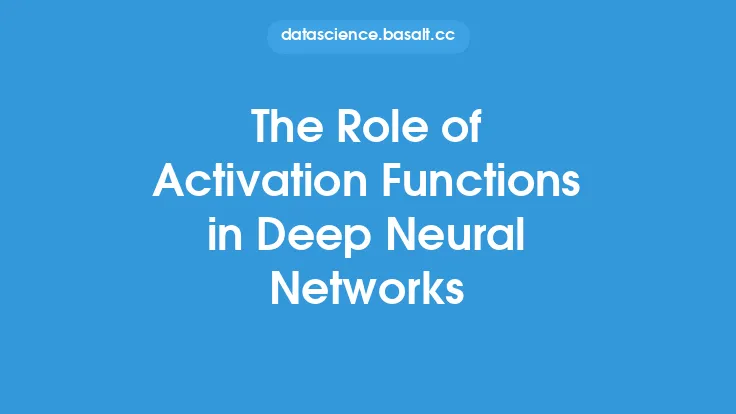Deep neural networks are a fundamental component of deep learning, a subset of machine learning that has revolutionized the field of artificial intelligence. These complex networks are composed of multiple layers of interconnected nodes or "neurons," which process and transform inputs into meaningful representations. The architecture and components of deep neural networks are crucial to their ability to learn and generalize from data, making them a vital area of study in the field of deep learning.
Architecture of Deep Neural Networks
The architecture of a deep neural network refers to the overall structure and organization of its components. A typical deep neural network consists of an input layer, one or more hidden layers, and an output layer. The input layer receives the input data, which is then propagated through the network, layer by layer, until it reaches the output layer. Each layer is composed of a set of nodes or neurons, which perform a specific computation on the input data. The connections between nodes in different layers are represented by weights and biases, which are adjusted during the training process to minimize the error between the network's predictions and the true outputs.
The hidden layers of a deep neural network are where the majority of the computation takes place. These layers can be further divided into different types, such as convolutional layers, recurrent layers, and fully connected layers. Convolutional layers are typically used in image and signal processing tasks, and are designed to capture local patterns and features in the input data. Recurrent layers, on the other hand, are used in sequential data such as text, speech, or time series data, and are designed to capture temporal relationships and patterns. Fully connected layers, also known as dense layers, are used in a variety of tasks, and are designed to capture complex, non-linear relationships between the input and output data.
Components of Deep Neural Networks
The components of a deep neural network include the nodes or neurons, the connections between them, and the activation functions that are applied to the output of each node. The nodes or neurons are the basic computing units of the network, and are responsible for receiving one or more inputs, performing a computation on those inputs, and producing an output. The connections between nodes are represented by weights and biases, which determine the strength of the connection between the nodes and the amount of output that is produced.
The activation functions are a critical component of deep neural networks, as they introduce non-linearity into the network and allow it to learn and represent more complex relationships between the input and output data. Common activation functions used in deep neural networks include the sigmoid function, the tanh function, and the ReLU (rectified linear unit) function. The sigmoid function maps the input to a value between 0 and 1, while the tanh function maps the input to a value between -1 and 1. The ReLU function, on the other hand, maps all negative values to 0 and all positive values to the same value.
Types of Deep Neural Networks
There are several types of deep neural networks, each with its own strengths and weaknesses. Convolutional neural networks (CNNs) are a type of deep neural network that is commonly used in image and signal processing tasks. These networks use convolutional and pooling layers to extract features from the input data, and are often used in applications such as image classification, object detection, and segmentation.
Recurrent neural networks (RNNs) are a type of deep neural network that is commonly used in sequential data such as text, speech, or time series data. These networks use recurrent connections to capture temporal relationships and patterns in the input data, and are often used in applications such as language modeling, machine translation, and speech recognition.
Autoencoders are a type of deep neural network that is commonly used for dimensionality reduction, anomaly detection, and generative modeling. These networks consist of an encoder and a decoder, and are trained to reconstruct the input data from a lower-dimensional representation. Generative adversarial networks (GANs) are a type of deep neural network that is commonly used for generative modeling and unsupervised learning. These networks consist of a generator and a discriminator, and are trained to generate new samples that are indistinguishable from the real data.
Training Deep Neural Networks
Training a deep neural network involves adjusting the weights and biases of the connections between nodes to minimize the error between the network's predictions and the true outputs. This is typically done using a variant of the stochastic gradient descent (SGD) algorithm, which iteratively updates the weights and biases based on the gradient of the loss function with respect to the model's parameters.
The choice of loss function and optimization algorithm can have a significant impact on the performance of the network. Common loss functions used in deep learning include the mean squared error (MSE) and the cross-entropy loss. The MSE loss is commonly used in regression tasks, while the cross-entropy loss is commonly used in classification tasks.
Challenges and Limitations of Deep Neural Networks
Despite their many successes, deep neural networks are not without their challenges and limitations. One of the main challenges is the need for large amounts of labeled training data, which can be time-consuming and expensive to obtain. Another challenge is the risk of overfitting, which occurs when the network is too complex and learns the noise in the training data rather than the underlying patterns.
Deep neural networks can also be sensitive to the choice of hyperparameters, such as the learning rate, batch size, and number of hidden layers. The choice of activation function and optimization algorithm can also have a significant impact on the performance of the network. Finally, deep neural networks can be vulnerable to adversarial attacks, which are designed to mislead the network into making incorrect predictions.
Future Directions and Applications
Despite the challenges and limitations, deep neural networks have many potential applications in a variety of fields, including computer vision, natural language processing, and robotics. Future directions for research include the development of more efficient and scalable training algorithms, the use of transfer learning and domain adaptation to adapt networks to new tasks and environments, and the development of more robust and secure networks that are resistant to adversarial attacks.
The use of deep neural networks in real-world applications is also becoming increasingly common, with applications in areas such as image and speech recognition, natural language processing, and autonomous vehicles. As the field of deep learning continues to evolve, we can expect to see even more innovative and powerful applications of deep neural networks in the future.





